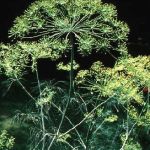| Common Name: |
Indian Balmony |
| Other Names: |
Chiretta, Brown Chirata |
| Botanical Name: |
Swertia chirata syn. Ophelia chirata |
| Genus: |
Swertia |
| Family: |
Gentianaceae |
| Native Location: |
Himalayas (Kashmir, Bhutan, and Khasi Hills) |
| Cultivation: |
Moist, well-drained soil in sun or partial shade. |
| Propagation: |
By seed sown in autumn or spring. |
| Harvest: |
Plants are cut toward the end of flowering and dried for use in infusions, liquid extracts, and powder. |
| Height: |
1.5m (5ft) |
| Width: |
60cm (2ft) |
| Hardiness: |
Z4-9 |
| Parts Used: |
Whole plant |
| Properties: |
An extremely bitter, tonic herb that lowers fever and improves digestion. |
| Medicinal Uses: |
Internally for liver and gall bladder complaints, dyspepsia, constipation, malaria, hiccups, and convalescent debility. |
| Bibliography: |
The Encyclopedia or Herbs by Deni Bown Copyright © 1995, 2001 Dorling Kindersley Limited. pg. 377 |

